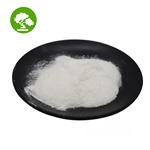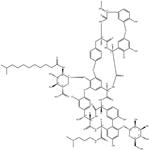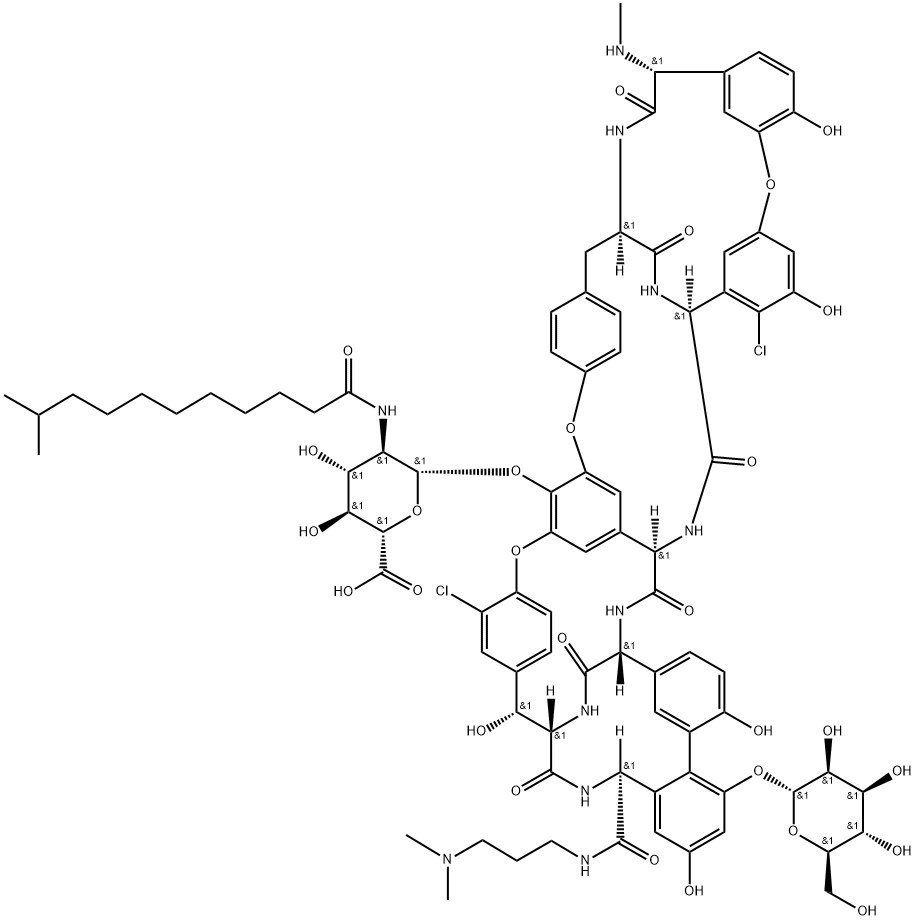Dalbavancin
- CAS No.
- 171500-79-1
- Chemical Name:
- Dalbavancin
- Synonyms
- 5,31-Dichloro-38-de(methoxycarbonyl)-7-demethyl-19-deoxy-56-O-[2-deoxy-2-(10-methylundecanamido)-beta-D-glucopyranuronosyl]-38-[N-[3-(dimethylamino)propyl]carbamoyl]-42-O-alpha-D-mannopyranosyl-N15-methylristomycin A aglycone;Dalvance;5,31-Dichloro-38-de(methoxycarbonyl)-7-demethyl-19-deoxy-56-O-[2-deoxy-2-[(10-methyl-1-oxoundecyl)amino]-β-D-glucopyranuronosyl]-38-[[[3-(dimethylamino)propyl]amino]carbonyl]-42-O-α-D-mannopyranosyl-N15-methyl-Ristomy;Ristomycin A aglycone, 5,31-dichloro-38-de(methoxycarbonyl)-7-demethyl-19-deoxy-56-O-[2-deoxy-2-[(10-methyl-1-oxoundecyl)amino]-β-D-glucopyranuronosyl]-38-[[[3-(dimethylamino)propyl]amino]carbonyl]-42-O-α-D-mannopyranosyl-N15-methyl-;zeven;VER001;CS-2250;DB/ QTH04;MDL 63397;Dalbavacin
- CBNumber:
- CB41028737
- Molecular Formula:
- C88H100Cl2N10O28
- Molecular Weight:
- 1816.71
- MDL Number:
- MFCD09837770
- MOL File:
- 171500-79-1.mol
| Melting point | >160°C (dec.) |
|---|---|
| Density | 1.59 |
| storage temp. | -20°C |
| solubility | Aqueous Base (Slightly), DMSO (Slightly, Heated), Water (Slightly) |
| form | powder |
| pka | 2.73±0.70(Predicted) |
| color | white to beige |
| FDA UNII |
DALBAVANCIN (808UI9MS5K) DALBAVANCIN B0 (B0U42518WL) |
| NCI Drug Dictionary | dalbavancin |
| ATC code | J01XA04 |
SAFETY
Risk and Safety Statements
| Symbol(GHS) |  GHS07 |
|---|---|
| Signal word | Warning |
| Hazard statements | H315-H319-H335 |
| Precautionary statements | P261-P305+P351+P338 |
Dalbavancin price More Price(18)
| Manufacturer | Product number | Product description | CAS number | Packaging | Price | Updated | Buy |
|---|---|---|---|---|---|---|---|
| Sigma-Aldrich | SML2378 | Dalbavancin ≥90% (HPLC) | 171500-79-1 | 5mg | $88.8 | 2024-03-01 | Buy |
| Sigma-Aldrich | SML2378 | Dalbavancin ≥90% (HPLC) | 171500-79-1 | 25mg | $359 | 2024-03-01 | Buy |
| Cayman Chemical | 21161 | Dalbavancin ≥98% | 171500-79-1 | 1mg | $33 | 2024-03-01 | Buy |
| Cayman Chemical | 21161 | Dalbavancin ≥98% | 171500-79-1 | 5mg | $83 | 2024-03-01 | Buy |
| Cayman Chemical | 21161 | Dalbavancin ≥98% | 171500-79-1 | 10mg | $131 | 2024-03-01 | Buy |
Dalbavancin Chemical Properties,Uses,Production
description
Dalbavancin is a second generation, semi-synthetic lipoglycopeptide antibiotic that is active against gram-positive pathogens with a MIC90for Staphylococcus aureus of 0.06 μg/mL. Dalbavancin possesses more potent in vitro bactericidal activity than vancomycin or teicoplanin against many resistant Gram-positive organisms such as MRSA. Dalbavanacin displays prolonged terminal half-life in adults.Compared to existing glycopeptides anti-MRSA(Methicillin-Resistant Staphylococcus Aureus) antibiotics, it has better antibiotic strength and, because it only needs to be taken once a week, it will be easier for both patients and medical care providers. It also offers stable absorption and metabolism for patients with light to moderate kidney and liver dysfunction. We know that its interactions with other medications are extremely small, and it is proving to be very safe in clinical trials.
Dalbavancin is specifically indicated for the treatment of adult patients with acute bacterial skin and skin structure infections (ABSSSI) caused by susceptible isolates of the following Gram-positive microorganisms: Staphylococcus aureus (including methicillinsusceptible and methicillin-resistant strains), Streptococcus pyogenes, Streptococcus agalactiae and Streptococcus anginosus group (including S. anginosus, S. intermedius, S. constellatus).
Class Glycopeptide anti-MRSA antibiotic
Mechanism of Action Cell Wall Peptidoglycan Synthesis Inhibitor
Target Indication MRSA Infections
a new lipoglycopeptide
Dalbavancin is a new lipoglycopeptide that is active against Gram-positive pathogens, including methicillin-resistant Staphylococcus aureus. It has a half-life of 14.4 days, permitting intravenous treatment of acute bacterial skin and skin structure infections without the need for daily dosing.
Dalbavancin was approved in 2014 by regulatory agencies in the United States (USA) and Europe for the treatment of skin and skin structure infections. The activity of dalbavancin was also widely assessed against Streptococcus pneumoniae clinical isolates collected from patients on six continents monitored during two time intervals (2011-2013 and 2014). A total of 18,186 pneumococci were obtained from 49 nations and submitted to a monitoring laboratory as part of the SENTRY Antimicrobial Surveillance Program for reference susceptibility testing. Dalbavancin potency against S. pneumoniae was consistent across the monitored years with a MIC50/90 of 0.015/0.03 μg/ml and all isolates were inhibited at ≤ 0.12 μg/ml. The activity for dalbavancin was not adversely influenced by non-susceptibility to β-lactams (ceftriaxone or penicillin), macrolides, clindamycin, fluoroquinolones, tetracyclines or multidrug-resistance (MDR). Regional variations of dalbavancin activity was not detected, but S. pneumoniae isolated in the Asia-Pacific region were more likely to be non-susceptible to penicillin and ceftriaxone as well as being MDR, compared to North or South America and Europe. Direct comparisons of potency illustrated dalbavancin (MIC50/90 of 0.015/0.03 μg/ml) to be 16-fold or more active than vancomycin (MIC50, 0.25 μg/ml), linezolid (MIC50, 1 μg/ml), levofloxacin (MIC50, 1 μg/ml), ceftriaxone (MIC90, 1 μg/ml), and penicillin (MIC90, 2 μg/ml). In conclusion, dalbavancin had potent and consistent activity against this contemporary (2011-2014) collection of S. pneumoniae isolates.
Mechanisms of action
Dalbavancin is characterised as a second-generation bactericidal glycopeptide. Other examples of the glycopeptide class include vancomycin, teicoplanin, oritavancin (formerly LY-333328) and telavancin (formerly TD-6424). Like other glycopeptides, dalbavancin's mechanism of action involves the formation of a complex with the C-terminal d-alanyl-d-alanine of growing peptidoglycan chains, thereby inhibiting bacterial cell wall biosynthesis. In addition, dalbavancin appears to have the unique ability to dimerise and anchor its lipophilic side chain in the bacterial membranes. This is hypothesised to increase the affinity of dalbavancin for its target and to increase its antimicrobial potency. Consequently, dalbavancin possesses more potent in vitro bactericidal activity than vancomycin or teicoplanin against many resistant Gram-positive organisms such as MRSA.
Originally developed by Vicuron Pharmaceuticals Inc., (Fremont, CA, USA) dalbavancin (Figure 1) was chemically derived from parent compound A-40926, a naturally occurring teicoplanin-like glycopeptide produced by the actinomycete Nonomuria spp. Modifications of the parent compound included derivatization of functional groups such as the C-terminus and N-terminus of the peptide, removal of sugars and the addition of acyl moieties.
Side effects
Adverse effects associated with the use of Dalbavancin(Dalvance) may include, but are not limited to, the following:
- nausea (4.7%)
- headache (3.8%)
- diarrhea (3.4%)
FDA approves Dalvance to treat skin infections
May 23, 2014,The U.S. Food and Drug Administration approved Dalvance (dalbavancin), a new antibacterial drug used to treat adults with skin infections.
Dalvance is intended to treat acute bacterial skin and skin structure infections (ABSSSI) caused by certain susceptible bacteria like Staphylococcus aureus (including methicillin-susceptible and methicillin-resistant strains) and Streptococcus pyogenes. The treatment is administered intravenously.
Dalvance is the first drug designated as a Qualified Infectious Disease Product (QIDP) to receive FDA approval. Under the Generating Antibiotic Incentives Now (GAIN) title of the FDA Safety and Innovation Act, Dalvance was granted QIDP designation because it is an antibacterial or antifungal human drug intended to treat serious or life-threatening infections.
Drug–drug interactions
Dalbavancin does not appear to be metabolised by the cytochrome P450 enzyme system. The administration of cytochrome P450 substrates, inhibitors or inducers do not affect dalbavancin's clearance rates. No drug–drug interactions have been identified. Furthermore, it is unknown whether dalbavancin has any cross-reactivity with glycopeptides as patients with a history of hypersensitivity have been excluded from these clinical trials. Recently, the in vitro drug interaction between dalbavancin in combination with nine different antimicrobial agents (clindamycin, daptomycin, gentamicin, levofloxacin, linezolid, oxacillin, quinupristin/dalfopristin, rifampin and vancomycin) was evaluated for either synergistic or antagonistic interactions. Antagonism was not observed between dalbavancin and any of the nine antimicrobials tested. In addition, there was no evidence of synergy observed between gentamicin and dalbavancin. However, dalbavancin and oxacillin appear to have some degree of synergy or partial synergy against staphylococci, including methicillin-resistant strains, VISA and enterococci. Further testing is needed to determine the clinical significance of these findings.
References: https://www.ncbi.nlm.nih.gov/pmc/articles/PMC1890846/
Drugbank Description
Dalbavancin is a second-generation lipoglycopeptide antibiotic that was designed to improve on the natural glycopeptides currently available, such as vancomycin and teicoplanin. Modifications from these older glycoprotein classes allowed a similar mechanism of action with increased activity and once weekly dosing. Its use is indicated for the treatment of acute bacterial skin and skin structure infections (ABSSSI) caused by the following gram-positive microorganisms: Staphylococcus aureus (including methicillin-susceptible and methicillin-resistant strains), S. pyogenes, S. agalactiae, and S. anginosus group (including S. anginosus, S. intermedius, and S. constellatus). Dalbavancin acts by interfering with cell wall synthesis by binding to the D-alanyl-D-alanine terminus of nascent cell wall peptidoglycan and preventing cross-linking.
References: http://www.drugbank.ca/drugs/DB06219
Uses
Dalbavancin is a second-generation lipoglycopeptide antibiotic. It is a semisynthetic lipoglycopeptide that was designed to improve upon the natural glycopeptides currently available, vancomycin and teicoplanin.
Uses
Dalbavancin is a semi-synthetic glycopeptide prepared from A40926 by introducing a positively charged lipophilic moiety in a previously unexplored region of the natural glycopeptide. This modification provides a longer in vivo half life, and improved in vitro activity against a variety of Gram positive and multi-drug resistant isolates such as MRSA and MRSE.
Definition
ChEBI: A semisynthetic glycopeptide used for the treatment of acute bacterial skin and skin structure infections caused or suspected to be caused by susceptible isolates of designated Gram-positive microorganisms including MRSA.
Dalbavancin Preparation Products And Raw materials
Raw materials
Preparation Products
| Supplier | Tel | Country | ProdList | Advantage | |
|---|---|---|---|---|---|
| Hangzhou ICH Biofarm Co., Ltd | +undefined8613073685410 | sales@ichemie.com | China | 985 | 58 |
| Shaanxi Haibo Biotechnology Co., Ltd | +undefined18602966907 | qinhe02@xaltbio.com | China | 1000 | 58 |
| Henan Tianfu Chemical Co.,Ltd. | +86-0371-55170693 +86-19937530512 | info@tianfuchem.com | China | 21691 | 55 |
| Nanjing Finetech Chemical Co., Ltd. | 025-85710122 17714198479 | sales@fine-chemtech.com | CHINA | 885 | 55 |
| ATK CHEMICAL COMPANY LIMITED | +undefined-21-51877795 | ivan@atkchemical.com | China | 32480 | 60 |
| AB PharmaTech,LLC | 323-480-4688 | United States | 989 | 55 | |
| Biochempartner | 0086-13720134139 | candy@biochempartner.com | CHINA | 967 | 58 |
| Cangzhou Wanyou New Material Technology Co.,Ltd | 18631714998 | sales@czwytech.com | CHINA | 906 | 58 |
| BOC Sciences | +1-631-485-4226 | inquiry@bocsci.com | United States | 19553 | 58 |
| Shanghai Longyu Biotechnology Co., Ltd. | +8615821988213 | info@longyupharma.com | China | 2531 | 58 |
Related articles
- Dalbavancin---semisynthetic lipoglycopeptide
- Dalbavancin (Zeven, Pfizer Inc.) is a semisynthetic lipoglycopeptide with an extended half-life that enables once-weekly dosin....
- Mar 10,2022
View Lastest Price from Dalbavancin manufacturers
| Image | Update time | Product | Price | Min. Order | Purity | Supply Ability | Manufacturer | |
|---|---|---|---|---|---|---|---|---|
 |
2024-04-12 | Dalbavancin
171500-79-1
|
US $0.00 / kg | 1kg | 99% | 2000ton | Shaanxi Haibo Biotechnology Co., Ltd | |
 |
2023-11-01 | Dalbavancin
171500-79-1
|
US $0.00-0.00 / kg | 0.5kg | 99% HPLC | 100kg | Hangzhou ICH Biofarm Co., Ltd | |
 |
2021-08-12 | Antibotic Dalbavancin
171500-79-1
|
US $10.00 / KG | 1g | 99 | 100kg/kg | Shijiazhuang tongyang Import and Export Co., LTD |
-

- Dalbavancin
171500-79-1
- US $0.00 / kg
- 99%
- Shaanxi Haibo Biotechnology Co., Ltd
-

- Dalbavancin
171500-79-1
- US $0.00-0.00 / kg
- 99% HPLC
- Hangzhou ICH Biofarm Co., Ltd
-

- Antibotic Dalbavancin
171500-79-1
- US $10.00 / KG
- 99
- Shijiazhuang tongyang Import and Export Co., LTD





